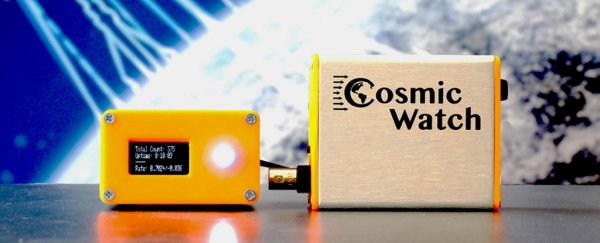What do you get the friend who has everything these holidays? A muon detector! You can almost see the look of surprise on their face already.
But I'm no millionaire, I hear you say. Rest assured, now you don't need to be – physicists at MIT have the solution in the form of a muon detector that costs a measly US$100 to build.
Before you rush off to your nearest department store to scout among the toasters and Playstations, these things aren't in mass production. That said, if MIT graduate student Spencer Axani had his way, there would be one in every home.
"If you make 100,000 of these, it starts becoming a very large detector," Axani told Symmetry Magazine.
"Instrumenting airplanes and ships would let you start measuring cosmic ray rates around the world."
Ok, so your friend whom you barely know from Facebook might take a bit of convincing to see the benefits of having their very own muon detector.
Just point out that right now there's a cascade of cosmic rays striking the atmosphere, causing larger particles to decay into fundamental particles called muons – the slightly more beefy cousin to the electron.
They exist for barely 2.2 microseconds, but still manage to slip down to the surface at a fairly decent rate, occasionally being blocked by denser materials.
"So?" your friend says.
"Well, so pyramids!" you retort triumphantly – muons scattering down from the heavens were used recently to confirm the existence of a chamber deep inside the Great Pyramid of Giza.
If your friend isn't into ancient history or hidden compartments, you could explain how cosmic rays themselves are still something of a mystery and muons might help us understand their origins.
By this stage they'll be absolutely convinced, no doubt. And will want to know more about this amazing little device.
Most bulky muon detectors use photomultiplying tubes to amplify light that flashes every time a muon hits a scintillator.
Axani and his team were able to replicate this set-up using relatively common electrical parts, which is why it's so cheap. The prototype was contained inside a PVC pipe and used toluene – a foul smelling liquid – as a scintillator.
With a number of refinements, each device is now about the size of a small phone, and relatively easy to make. And no doubt smells a lot better.
If you're really feeling quite savvy and your soldering iron is running hot, the researchers have published the instructions on how to build one yourself on their CosmicWatch website.
They claim your average high school student could put one together in about four hours. If the student wanted to churn them out for all of their buddies, they could get their game on and reduce the time down to about an hour per device.
Once your friend has their handy muon detector in their pocket, they can take it virtually anywhere to measure the steady plinking of subatomic muons striking their bodies. They'll be the centre of attention for sure.
"You get funny looks when you take particle detectors into the subway, but we did that in Boston," says Axani.
"Since the muon rate will decrease the further down you go, we put the detectors in a subway station to measure how far underground we were."
Initially Axani was interested in building a simple muon detector to bury with the neutrino-catching IceCube observatory under the South Pole, to help differentiate between particles.
Now their project has evolved into an outreach program, with devices being distributed as far away as Warsaw in Poland, where students are sending them skyward in planes and weather balloons to measure muons high in the atmosphere.
"At sea level, you might see one count every two seconds … but on a plane at cruising altitude, that rate increases by about a factor of 50 – a dramatic change," says Axani.
"From the measured rate you can back-calculate what the actual altitude of the plane was."
The sky is literally the limit for these cheap muon detectors, which opens research to all sorts of citizen science endeavours.
Come to think of it, you'll probably even want to keep the device all to yourself. In which case, spend less than US$100 on some other great piece of tech your friend probably won't thank you for.
This research was published in the American Journal of Physics.
